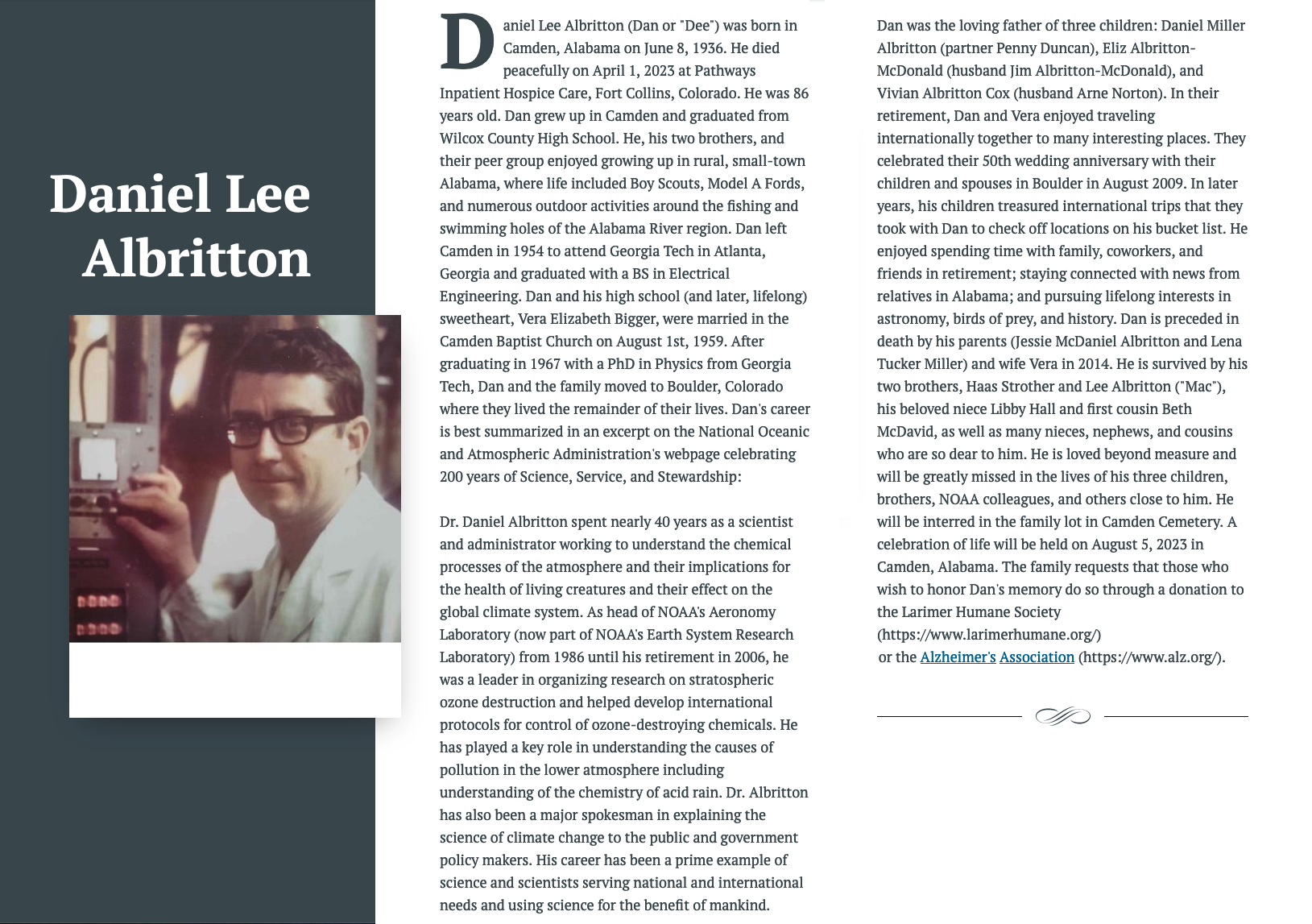A .gov website belongs to an official government organization in the United States.
A lock () or https:// means you've safely connected to the .gov website. Share sensitive information only on official, secure websites.
15 April 2023
We are saddened to learn that Daniel L. Albritton (1936-2023), a founding member of our laboratory passed away April 1 in Fort Collins, Colorado.
We are collecting tributes to Dan on this webpage. Please reach out to Cathy Burgdorf Rasco if you would like to contribute.
Dan is a recipient of a 2022 Haagen-Smit Clean Air Award for his air quality improvement achievements in the category of policy. As fate would have it, his letter arrived a couple of days after he passed away. Dan is very deserving of such prestige and will be awarded posthumously. More information
Steve Thur, OAR Assistant Administrator
I write to you with a heavy heart about our dear friend and colleague, Dr. Daniel L. Albritton who peacefully passed away this April 1, 2023 at Pathways Inpatient Hospice Care, Fort Collins, Colorado. He was 86 years old. Among other roles, Dan served as the Director of NOAA's Aeronomy Laboratory (now part of ESRL) in Boulder.
Dan was an award-winning leader in climate science, an amazing partner and collaborator, an innately creative and clever storyteller, and a dear, generous friend to so many. His work and drive to understand and, most importantly, explain the complexity of climate change to all knew no bounds.
Dr. Spinrad, who worked with Dan for many years, has shared the following upon learning of his passing: "I treasured my interactions with Dan from the first day we met. As with so many others who met Dan, I learned so much from him and was permanently influenced by his extraordinary knowledge and razor-sharp communication skills. One of the highlights of my time working with him was establishing the Daniel L. Albritton Outstanding Science Communicator Award, a way of memorializing his style, intellect and insight. I will miss him deeply."
Dr. Albritton remains one of the most effective communicators of NOAA research and related science. His near 40 year career exemplifies a scientist serving national and international needs and using science for the benefit of all people. We will remember Dan not just as a research leader in confronting scientific challenges of the day such as ozone-destroying chemicals, acid rain, and urban smog, but also as a massively influential communicator and educator. Because of his avuncular and professorial demeanor, he was adept at explaining the science of climate change to the general public as well as all levels of government policy makers – including the White House. It is because of his outreach and education efforts with such decision-makers that we benefit from both the Montreal Protocol and the Clean Air Act.
I encourage you to read more about our cherished colleague in his obituary and follow on to [this] memorial page. His celebration of life will be held on August 5, 2023 at his hometown of Camden, Alabama.
David Fahey, CSL Director
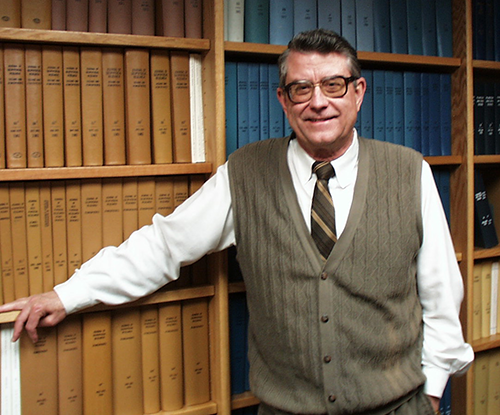
I had the great fortune to work with Dan as his last post-doctoral student on the flowing afterglow systems that he helped develop and master. Within my first year, he transitioned to program management in the Aeronomy Laboratory and then became our Director for more than 20 years before retiring in 2006. I learned much from him in the laboratory conducting reaction studies and in his office coauthoring papers. Later, he brought me into the science-policy world of the international Montreal Protocol on Substances that Deplete the Ozone Layer. He was a mentor for me on how to be of importance and value at the science-policy interface by being an honest broker of scientific information. He coached many of us on the principle of having our work be policy relevant while being policy neutral. In today's NOAA Chemical Sciences Laboratory (CSL), I continue to support that principle in our research.
Dan was a gentlemen and scholar. He received wide respect as a scientist, administrator, communicator, and leader. He was caring and gracious to laboratory staff and his many colleagues and associates outside the laboratory. He led the laboratory through the intense years after the discovery of ozone depletion and influenced policy as the first co-chair of the science panel of the Montreal Protocol. The laboratory emerged as a leader in air quality and climate research during his tenure. His communication skills both written and oral set him apart from his peers. His famous viewgraph transparencies were a principle tool in his communication repertoire. The OAR Daniel L. Albritton Outstanding Science Communicator Award was created in his honor to promote the importance of scientific communication within NOAA. His response to this honor was captured in a short video presentation.
The continued success of CSL as a premier national laboratory pursuing research in air quality, climate and stratospheric ozone is part of Dan's legacy as Director. CSL owes much to Dan and his tireless efforts and commitment to our mission over many years. Ravi Ravishankara and I have had the great privilege and responsibility to succeed him as CSL Director and uphold the culture of scientific research and science/policy support that he fostered.
Fred Fehsenfeld, CSL Senior Scientist
It was with great sadness we learned of the passing of Dan Albritton on April 1. But, the aims and goals he championed, the resulting unmatched successes and progress he achieved and the future use of his unique approach will be followed carefully in future times.
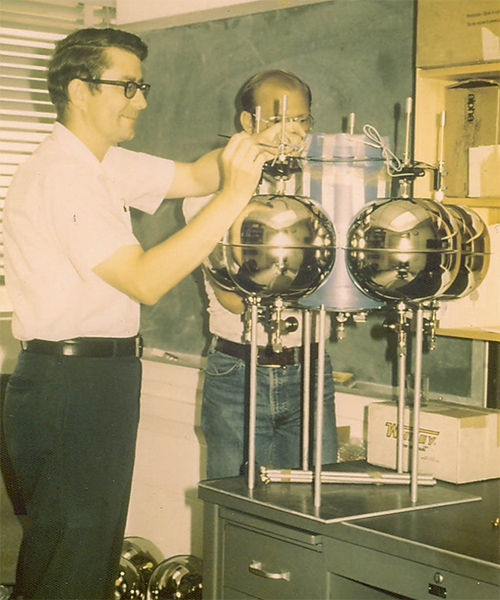
I first met Dan in 1967 when he joined our research group in the Aeronomy Laboratory. From that time, he went on to become an outstanding scientist and then later become an exceptional scientific administrator and internationally recognized scientific leader until his retirement in 2006.
As we reflect on how much Dan achieved, from my perspective I would like to briefly describe using three words, perception, persuasion, and progress, how he altered and managed the future research being undertaken by our laboratory. First, he used his unique abilities to affect a positive perception of the scientific accomplishments made by our science that was being done through the offices of NOAA. This allowed him to achieve effective and rapid progress in the evaluation, acceptance and certification of these results by upper management. And finally, even most significantly, the persuasion he used, to ensure that the future research being planned and developed by our laboratory would be supported to successfully achieve these goals.
Dan's success in these matters relied heavily on one of the fundamental aspects of his personality. He was a very organized person. His aim was to get straight to the point with the maximum amount of usable information in the minimum amount of time. This meant he aimed at achieving his stated goals with the least amount of filigree or diversions.
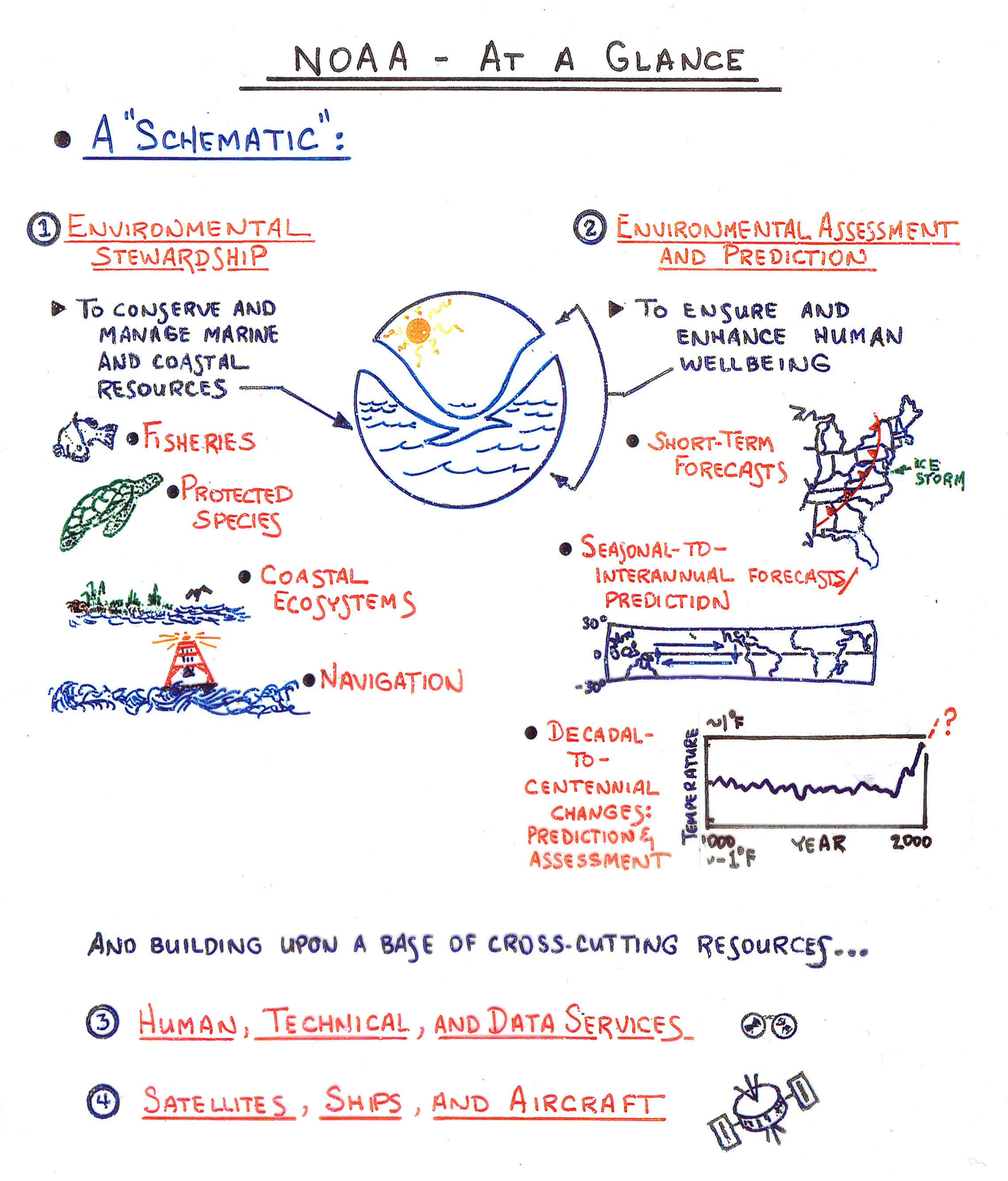
Fortunately, in order to achieve these goals, Dan had exceptional talent. Dan had a unique ability to cartoon research achievements and plans in a way that was informative, entertaining and, most importantly, thought provoking. He directed these with an aim to support and provide for our future research. This talent allowed him to simplify and restate complex science and the requisite required management approaches in simpler, more informative, understandable, and indeed entertaining, terms without distortion. Dan's cartoons proved that truth can be most succinctly told without using words. They often made his scientific and technical reports and the ongoing requisite research plans and undertaking more clear, direct and actionable.
Dan's articulation of our research allowed great advances to be made toward the certification of important scientific and environmental goals that we NOAA scientists, managers and administrators worked toward and hoped to achieve. Indeed, the NOAA Research Dr. Daniel L. Albritton Outstanding Science Communicator Award was established to identify a leading NOAA scientist or administrator whose work has best exemplified Dan's "perception, persuasion and progress" approach and the ensuing acceptance of past achievements and future plans that were presented.
I should also mention that Dan's organization was also reflected by his showing up at work each morning with several 3" X 5" Q-cards in the left pocket of his shirt that listed reminders, tasks and appointments he would undertake that day. I often kidded him that each card continued about a week's work and, for Dan, the work week had seven days.
On a more personal level, I must say, since the time I first met Dan, he was a superb colleague and dear friend to me. In addition, he was head of a marvelous family that included Vera, his lovely wife, and their three wonderful children, Elizabeth, Vivian and Danny that they unconditionally loved and adored.
Carleton J. Howard, NOAA Aeronomy Laboratory, 1971-2002
My first contact with Dan Albritton was through a letter he sent to me in 1971 as I was completing my thesis and preparing to move to Boulder to take a job in the NOAA Aeronomy Lab. I had previously met the three founding members of the group, Eldon Ferguson, Fred Fehsenfeld and Art Schmeltekopf, but I did not recognize his name. He identified himself as having joined the group a few years prior and offered to help me get settled when I arrived. His offer was greatly appreciated as I had never been in Boulder and had no personal connections there. True to his word, Dan helped me get settled in an apartment and a couple months later to move into a house.
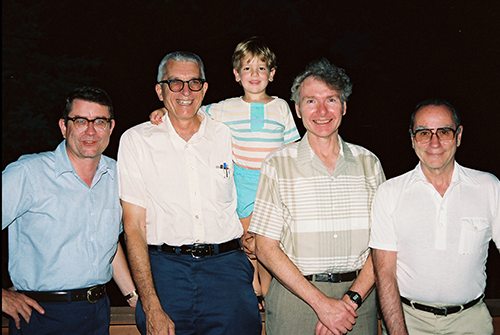
At that time, the senior members of the group went out to lunch together but after a few weeks, I realized that this was a stress on my budget and decided to brown-bag it. Soon Dan also dined-in, while Fred and Art went home and Eldon ate at the University Faculty Club. Dan and I often ate together and talked about things. We eventually developed a routine of going out to lunch once per week. I learned he came from a small town, Camden, Alabama, that his father was a pharmacist and owned a drug store, where Dan mastered the art of making a delicious milk shake employing a vintage Hamilton Beach blender. He later installed it to his home in Boulder. He was raised to be a thoughtful, polite young gentleman in the southern tradition. He knew that his future wife, Vera, was "the one" when she was still in middle school and theirs was a life-long love story. He developed an interest in the mechanics of the classic Model A Ford automobile. Relics could be found in yards and, if you're lucky, out of the weather, in barns and sheds in the 1950s. Dan collected several vehicles for parts, while he assembled a beautifully restored, fully-functioning coupe. He was fascinated by the simple yet intricate engineering of the machine. He had an early interest in astronomy and built a small observatory with a retractable roof.
We had a single main telephone line for the lab group and once, when I answered, a woman with a southern accent asked to speak to "Dee". I told her there was no one there by that name, only to learn later that Dee was Vera's name for Dan. The living room of their home was a library. We shared a love for classic English novels. The Public Television dramatizations of classics on Masterpiece Theatre on Sunday evenings were a frequent subject of lunchtime conversations on Mondays. He also enjoyed some popular music, telling me how creative and original he thought the music of Simon and Garfunkel was. A favorite was their "Sounds of Silence". At home he undertook a major project of building a perimeter fence around his back yard. The posts for the fence were massive concrete structures with an exposed aggregate finish. A classic Dan project, not to be finished on a weekend, but a high-quality unique product, thoughtfully designed, artfully completed over months and intended to last forever. We shared an interest in coin collecting. While mine was fiscally limited to pennies, Dan assembled a remarkable collection of silver coins with a focus on quality. He thought the walking liberty half-dollar was one of the most beautiful coins ever minted in the US. He spoke often of his kids' projects and activities but his descriptions never sounded boastful, although all three were highly successful. When one was living away from home, he faithfully sent them a postcard report nearly every day.
In the early '70s Dan took on the responsibility of mentoring Mack McFarland, a chemistry graduate student at the University of Colorado. They settled on a project to design and build a flow-drift ion reactor. The concept was to combine the collision energy versatility of a drift-tube, which Dan used in his graduate work, with the chemical versatility of the ion flow reactor, which was invented by the group's founders. The product instrument was an enormous success and generated numerous important developments and data. He also collaborated with Art Schmeltekopf and Dick Zare on a project that revolutionized the analysis of the spectroscopic data of diatomic molecules. They applied modern mathematical techniques and computer programming to extract improved physical constants from laboratory data. Dan carried a heavy load in programming and analysis to complete the project and at the end, he took a tour to describe the work at the leading spectroscopy labs around the world.
In the mid-1970s the senior scientists in the group recognized that their focus on ionic processes in the upper atmosphere was not relevant to the mission of the NOAA Environmental Research Lab, and projects were initiated to study the composition of the troposphere and stratosphere, where it was being recognized that human activity and pollution were having significant impacts on the natural environment. The scientists leading the programs realized that this new direction required consolidation and organization and requested that Dan be appointed the program leader. This request demonstrated the recognition of Dan's intelligence, thoughtfulness and fairness. He never showed any signs of ego or self-promotion. If he undertook a job, one could be certain that it would be completed thoroughly and accurately. Not surprisingly, he rose to become the Aeronomy Lab director and established a remarkable reputation as a great leader and communicator in international environmental affairs. Through it all, he always maintained his polite southern demeanor. It was a wonderful experience to be a friend and colleague. My wife, Veronica Bierbaum, and I were honored that Dan stood as our best man in 1982.
Eddie Bernard, NOAA Pacific Marine Environment Laboratory (PMEL) Director - 1982-2011
During my first Environmental Research Laboratory Directors' meeting in 1981, I met Eldon Ferguson and Dan Albritton. Eldon was the Aeronomy Lab Director and Dan attended to make a presentation on the ozone problem. Other Directors in attendance were Joe Smagorinsky, Ed Kessler, Lester Machta, all of whom were outstanding scientists in their respective fields.
Eldon was a dynamic force that stood out among the group. Then, Dan made one of his legendary presentations with his hand drawn accents. The group patiently listened and asked some pointed questions to which Dan answered in his gentle, effective manner.
I was struck by the contrasting personalities between Eldon and Dan. But combined, they were very effective in receiving the highest rating among the initiatives presented at the meeting. Later, at another Lab Director's meeting when Dan was the Director, I had a chance to lunch with Dan. I asked him how he became such a considerate person. He replied that he worked in his Dad's soda fountain as a youth in Alabama and was responsible for treating people well so they would return. I told Dan that I had a similar experience when I worked in my Aunt's snowball stand in Louisiana. We both shared a hearty laugh.
Dan was the most respected Lab Director. When Dan spoke, people listened. His communication skills were only surpassed by his gentle, yet persuasive, interactions with others. These skills propelled Dan into a position that enabled him "to change the world." The world needs more Dans to meet our current challenges. He will be missed, but his influence lives on.
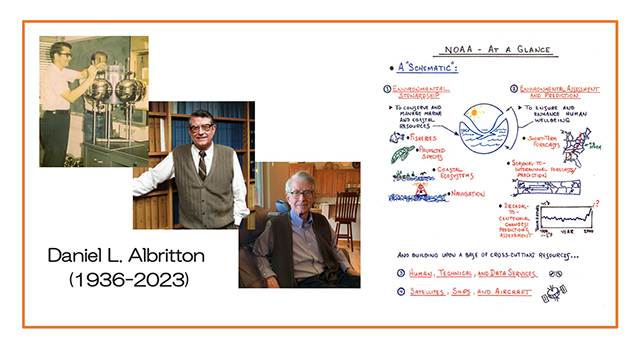
Excerpt from her opening remarks, Megumi Seki, Executive Secretary, Ozone Secretariat, at the 45th Meeting of the Open-ended Working Group of the Parties to the Montreal Protocol in Bangkok, Thailand, on 3 July 2023.
I would like to begin today by remembering Dr. Daniel Albritton, who passed away on 1st April this year.
Dr. Albritton was one of the first co-chairs of the Scientific Assessment Panel (SAP). He steered the SAP through several quadrennial assessments during the first two decades of the Montreal Protocol. He was an acclaimed atmospheric scientist and an amazing communicator who was able to convey complex science to decision makers and the public in simple language. It was under Dr. Albritton that the very popular 20 Q&A publication was conceived and published. He was not only a brilliant scientist, but a gentle person who treated everyone with respect, tolerance, and kindness.
Let us observe a minute of silence in remembrance and appreciation of Dr. Dan Albritton.
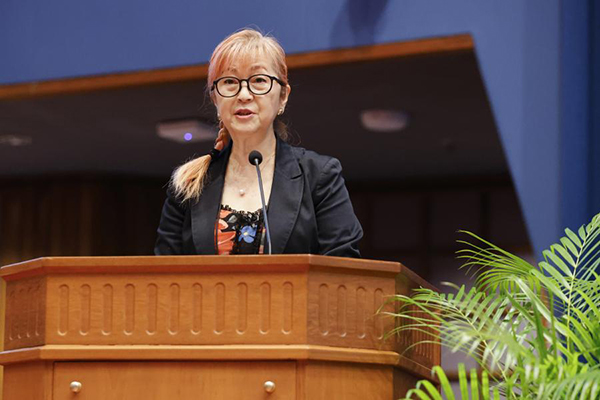
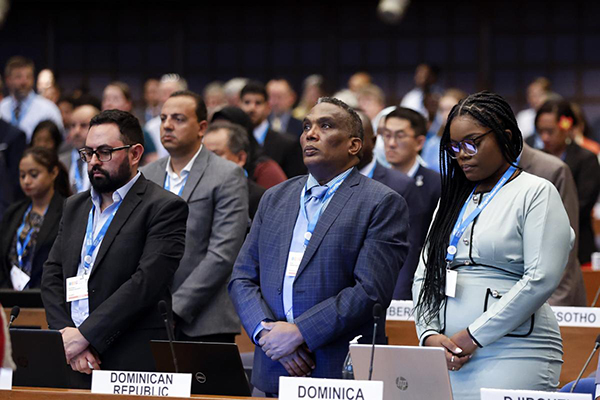
Nelson Sabogal, former Senior Scientist of the Ozone Secretariat
I remember all the Co-Chairs of the Scientific Assessment Panel and Environmental Effects Assessment Panel of the Montreal Protocol, especially with high respect Dr. Daniel L. Albritton for his respect, tolerance to everybody including scientists from developing countries. His hand-drawn graphics on the acetates are historical!
I met Dr. Albritton for the first time during the peer-review meeting of the Scientific Assessment of Ozone Depletion held in October 1991 in Les Diablerets, Switzerland. This was memorable for me. Dr. Albritton worked tirelessly with all the scientists who contributed to the report of the Scientific Assessment Panel and harmoniously with Dr. Robert T. Watson, who normally reported back to the Parties (Governments) of the Montreal Protocol.
This was the report: WMO, UNEP, NOAA, NASA, UK Department of the Environment, Scientific Assessment of Ozone Depletion: 1991, World Meteorological Organization, Global Ozone Research and Monitoring Project-Report No. 25, 1991.
The scientific assessments supported the decisions of the Parties to develop and strengthen the Montreal Protocol together with the Environmental Effects and Technology and Economic assessment panels. I continued to meet Dr. Albritton more frequently since 1993 when I joined as the Scientist of the Secretariat for the Vienna Convention and the Montreal Protocol (Ozone Secretariat) of the United Nations Environment Programme (UNEP).
The 1994 Scientific Assessment was led by Dr. Albritton, Dr. Watson, and Dr. Piet J. Aucamp of the Department of National Health in South Africa South Africa.
The 1998 Scientific Assessment was steered again by Dr. Albritton, Dr. Watson, Dr. Aucamp and with Dr. Gérard Mégie of the Centre National de la Recherche Scientifique, France.
In 1999, we were putting together the UNEP, Synthesis of the Reports of the Scientific, Environmental Effects, and Technology and Economic Assessment Panels of the Montreal Protocol, A Decade of Assessments for Decision Makers Regarding the Protection of the Ozone Layer: 1988-1999, United Nations Environment Programme, Synthesis Report Editorial Team: D. L. Albritton, S.O. Andersen, P. J. Aucamp, S. Carvalho, L. Kuijpers, G. Mégie, X. Tang, M. Tevini, J. van der Leun, R. T. Watson, N. Sabogal, pp. 161, 1999. I worked nicely with all the Co-chairs of the Panels of the Montreal Protocol.
During the preparation of the 2002 Scientific Assessment that was led again by Dr. Albritton, Dr. Mégie, Dr. Ayité-Lô Nohende Ajavon of the Université de Lomé, Togo, and Dr. Watson, I met and worked harmoniously with Dr. Albritton.
Adrian Tuck, NOAA Aeronomy Lab / ESRL CSD - 1986-2007
I first met Dan Albritton at a WMO meeting in Feldafing, West Germany, in 1984. I knew his name from the literature in connection with the Λ-doubling in OH in my physical chemistry days, prior to becoming a meteorologist. Although it was not apparent at the time, that meeting, organized by Bob Watson, was a turning point in the stratospheric ozone story. The then Aeronomy Laboratory was represented by Dan, Art Schmeltekopf, Dieter Kley and Susan Solomon. Sherry Rowland talked about how chlorine nitrate reacted with HCl on the quartz surface of his flow reactor – and dismissed it as being of no consequence because there was no quartz surface in the stratosphere. That disappeared into history with Joe Farman's ozone hole paper in Nature the next year, followed by Susan's paper in 1986 attributing the ozone hole loss to that reaction on the surfaces of polar stratospheric clouds. Dan was quicker to grasp the significance of all this than anyone else, displaying wisdom as well as intelligence. An aftermath of that meeting was that Susan, Art and Dan persuaded Eldon Ferguson to offer me a job – to follow Dan as a program chief as he became Director when Eldon retired.
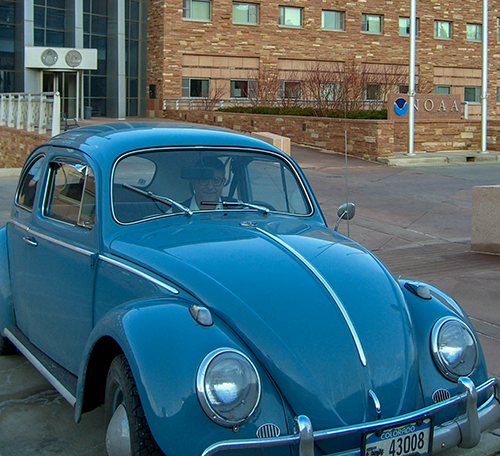
I resigned from the UK Meteorological Office in July 1986, and arrived in Boulder in early August. Dan picked Diane, son Matthew and me at Stapleton, driving us back to Boulder in the famed Blue Beetle, a 1963 VW model. He and Vera, and daughter Vivian entertained us to dinner at their house on Heidelberg and made every effort to make us welcome. This was characteristic of Dan, a real gentleman as well as being a first-class scientist. In the subsequent 21 years I came to appreciate how rare was his combination of intelligence, foresight and administrative ability cemented together with wisdom, backed up by phenomenal energy and persistence. He was a living proof of the dictum that there is no wisdom without intelligence, but there's plenty of intelligence without wisdom. He dealt with the all-too-common latter combination skilfully and diplomatically.
The Montreal Protocol owed a huge debt to Dan. In combination with Bob Watson, it was steered past the initial opposition from the Reagan administration and the even more tortuous vicissitudes of international politics. Dan had the wisdom to present the case rationally and objectively to the administrators and politicians in Washington, via his famous viewgraphs, hand drawn models of clarity. They were described by Colin Powell as steam age PowerPoints – and praised as being better. He never accompanied his expositions to politicians with a request for more research funding, something that gave the "Bob and Dan Show" unique credibility.
He was very sympathetic to my efforts to get better pay and promotion prospects for the scientists and engineers in the Meteorological Chemistry Program. They were high achievers beyond compare on the NASA airborne missions and were under recognised by the then NOAA structure. The stellar reputation that the Aeronomy Laboratory acquired was directly attributable to Dan's tactical and strategic foresight as Director. He was respected in the Federal Government, at International Organizations, in academia and in the chemical industry.
Farewell Dan, few scientists leave a legacy such as yours.
Jana Goldman, NOAA OAR PAO - 1999-2013
I was deeply saddened to learn of Dan Albritton's death.
I had the good fortune to work with this sweet, wise man when I was the Public Affairs Officer for NOAA's research office – the Office of Oceanic and Atmospheric Research or the beloved OAR, He taught me so much in his gentle, but learned way. Who can forget his hand-drawn transparencies – well before PowerPoint – showing the degrees of confidence in the data with a small thermometer along the side? In fact, they were featured in an Andy Revkin piece in the New York Times: You'll Want to Take Notes, Folks. There Will Be a Test.
My favorite story of this wonderful man was when the IPCC report came out just as George W. Bush was being inaugurated. We at NOAA knew of the IPCC findings and with Dan's help, created a briefing for the incoming administration. Evidently, that briefing never reached the new people. So, the day of the inauguration, the New York Times front page had the political news above the fold, but the IPCC findings below the fold.
Faster than you can say climate, Dan was summoned to Washington to explain this. In a meeting with the new administration, he met with the new Commerce Director – a friend of President Bush's – Donald Evans. Evans tried to find out Dan's views on nuclear power. All Dan would say was - nuclear doesn't emit greenhouse gases. Evans tried six ways to Sunday to get Dan to say one way or the other what he thought of nuclear power. But Dan always stuck to the science, and kept repeating that nuclear does not cause greenhouse gases.
Evans finally gave up. But I always used this example in my workshops with other scientists to show how one can share the science in a clear, factual way.
Dan was generous with his time and knowledge as he explained things to me so I could share them with the public. He was the consummate scientist and public servant.
My deepest sympathies to his family, his friends, and his colleagues. He will be greatly missed.
His memory will be a blessing.
Jeanne Waters, NOAA Aeronomy Lab / ESRL CSD Executive Administrative Assistant
In loving memory of Daniel L. Albritton ~ I collect quotes, and Dan provided some of my very best. Many of these I mentioned at the symposium and banquet in his honor on Monday, 8 May 2006. They say a lot about how well he connected with people, and demonstrate his wry sense of humor.
We had a beautiful day in Boulder that Monday. But ordinarily, Dan would note, "Monday is the sand-trap on the Golf Course of Life."
************
Many of my quotes involve Dan thanking someone else for their efforts. For example, he told a colleague that she had the "widest and deepest" view of a topic.
Another time he thanked someone for a replacement, saying, "I had not seen my copy surface on the 'paper sea' in several months!"
When a colleague took the responsibility for setting up a conference call with multiple participants, Dan gratefully told her, "Thanks for running the trotline on this."
************
Trying to keep organized, Dan wrote me a note: "If you have not done so already (I forget if I forgot), please send copies to ..."
On another occasion he commented, "It seems that I've been living in a popcorn popper recently."
Later, he lamented his juggling skills: "There are a lot of marbles up in the air simultaneously (and it's easy to lose one's marbles)."
Completing a project, he might say, "It was nice to get that little airplane off the deck."
Asking for a time extension, Dan explained, "We are in the throes of landing our Lab's budget airplane within the few % runway."
Speaking of budget, he was decisive that "I don't address allocations before the fiscal chickens hatch."
After volunteering to cover the page charges for a journal's special issue, Dan worried a bit about how costs had expanded. He noted, "The number and length of the papers have grown so much since the original plan and my stepping to the page-charge costs that I feel somewhat like I'm buying a "pig in a poke" (to use an Alabama expression for the purchase of a rather unknown quantity).
************
As commitments increased and deadlines shortened, Dan sometimes begged forgiveness for being tardy. "Cite temporary insanity," he told me on one occasion. Another time he apologized, "Sorry that we are the lamb's tail on the input. I have been 100% wrapped around the axle of the Program Baseline Assessment."
Dan was facing a very short-turnaround deadline when about 30 minutes prior to that deadline I asked him how it was going. He responded, "I think we've stamped those fires down to just a few embers right now ..."
************
While working on a project, I asked Dan whether he needed the 1995 separated from the 1996 publications. "Is it a '95, a '96 and a '95 again, or is it a batch of '95s and then a batch of '96s?" he asked. I told him it was a batch of one and then the others. "That's fine," he responded, "I just didn't want to have to unscramble the egg."
Another time he ended a detailed discussion of a topic by noting, "Well, I think we've pretty much scratched that field over, don't you think?"
One day I passed Dan and a colleague deep in conversation. Nodding approvingly, Dan was saying, "It's always good to scratch up a good news rock in a rough soil."
A cat fancier, I got a kick out of it when Dan used the phrases, "Busy as cats in a fish store" or "This is a different breed of cat."
************
Dan had a great understanding of scheduling - as he said, "If the World knows your schedule, the World will fill it for you."
Offered several dates for a meeting, Dan chose one. It was taken. He picked a second - also taken. Finally, he got his third choice, commenting that the speed at which the desirable dates had been grabbed reminded him of "chickens on a June bug." Noting that the farthest dates out had been the first ones taken, Dan said it reminded him of the professor who asked his class, "Do you want the physics test this Friday or next Friday?" and no one picked "this Friday!"
Declining an invitation for a meeting due to a personal conflict, Dan noted, "I complete another trip around the Sun on one of those days, and the family usually wants to express their amazement in some way."
************
Dan knew how to make tough decisions, though he acknowledged on one occasion, "Some of these suggestions may get pins stuck into my doll."
He also would cite what he called Newton's FOURTH Law of Motion: "Nothing moves unless someone pushes."
About the World Wide Web, Dan noted, "Whatever you put on it has to be maintained. You are then building yourself a very large house that you have to paint frequently."
************
He handled a medical setback with humor when he wrote several colleagues, "I've learned that I must have orthopedic surgery on my right shoulder. Like the king pins on my old '61 VW bug, the "66 thousand miles" on my shoulder joints have led to the need for a rebuild."
************
When Chris Ennis moved into her new home, Dan commented, "Three moves are equal to one fire."
One Veteran's Day, Dan and Chris were winding up a report. Chris was copying and collating, while Dan volunteered for the hole-punching and spiral binding with our manual machine, saying, "Let me do the punching - I'm hell on wheels on that machine."
One Halloween Chris wore her "puppy dog" hat with long floppy ears. Walking into her office and not missing a beat, Dan commented, "Ah. I thought I heard barking."
************
Howard Wesoky (formerly of NASA and FAA), said, "I consider this story to be a 'classic,' and hope somebody remembers if and when a retirement party is ever held for the 'cartoonist!'"
From Kevin Sullivan's Washington Post article, dateline KYOTO, Japan, December 4, 1997, titled, If You Understand UNFCCC-COP3, Then JUSSCANNZ Is a Snap:
If you think sinks are where you put dirty dishes and bubbles are what you use to clean them, you should stay away from this week's global climate summit here.
The hallways of Kyoto are filled with chatter about sinks and bubbles and juice cans and at least two baskets of gases, none of which mean what they sound like. There are a Group of Seven countries, a Group of 21 and a Group of 77 that is actually a group of more than 130. There is endless debate about CO2, CH4, N2O, SF6 and perfluorocarbons, and a scientist from something called an aeronomy laboratory using cartoons to explain what it all means.
************
In greater and greater demand in Washington, Dan was called to brief the Under Secretary of the Economics and Statistics Administration on the science of climate change. Shaking his head resignedly, Dan asked, "What is it somebody said? Don't do a good job at what you don't want to do again."
A comment Dan made about facing challenges has stuck with me. "At times like this, I try to remind myself of the Chinese symbol for 'change.' I'm told that it is made up of two separate symbols, for the words 'uncertainty' and 'opportunity' - interwoven into one symbol."
Finally, the comment Dan made to me on the passing of his longtime friend and colleague, Jerry Mahlman (director of NOAA's Geophysical Fluid Dynamics Laboratory from 1984-2000) resonates in my heart as the way I feel about losing Dan himself:
"Jeanne, It is sad, sad indeed. It's like the loss of one of the giant sequoias. The grove is diminished. Dan"
Dennis Baldocchi, University of California, Berkeley
Sad to hear of Dan's passing. When I was a junior scientist at NOAA Oak Ridge, I attended many meetings led by Dan, as we were working on dry deposition. I viewed Dan as a role model on how to lead fairly and effectively. I was very impressed how he ran meetings in a very professional manner. Scientifically, he led his lab to perform state of art research on atmospheric chemistry. He clearly had great knowledge and a keen eye on what needed to be done next. And he recruited the best people to do this work. He exemplified NOAA at its best.
Linda Albritton, Sister-in-law
My first encounter with Dan Albritton, Dee as his family called him, was at his younger brother's (soon to be my spouse) graduation from college. I knew Dee was smart as he was in last stages of his dissertation for a PhD in physics from Georgia Tech. I assumed he would be introverted and aloof but found him to be friendly, gracious, witty, a good conversationalist and a superb story teller. The day we met he told me a family story that had many twists and turns, which he told in a very engaging way. This gift of storytelling would serve him well in his scientific career.
I remember having an ah ha moment about Dee's career, that he was not just the run of the mill scientist but his work had implications for the entire planet! I was giving a talk to a group about the causes of ozone depletion, of which I had some prior knowledge from conversations with Dee. I had checked out a book in our library and a few pages in, my brother-in-law was quoted! There was his simple explanation and a drawing about CFCs' role in ozone depletion in the stratosphere, in language I could understand. This explanation was attributed to the competent scientist with the Clark Kent glasses, Dan Albritton.
Dee knew that policy makers and elected officials had to understand complicated scientific concepts about atmospheric science as they were the ones who could fund research and pass laws that would enact change. Presidents and people in administrative positions could have a role as every President sets priorities for legislative agendas. Dee often represented his NOAA lab before Congressional hearings. Recently watching Dee at a 1988 Congressional hearing on C Span, I realized that he was engaging these policy makers with a concise logical "story" just as he had engaged me with a family story when we first met. These stories however were about issues that had an effect on the entire planet. Like a good teacher he was able to break down complicated scientific concepts into understandable language so unscientific folks could grasp the concepts. There is a familiar expression, "a picture is worth a thousand words". Dee as we know, accompanied his talks with hand drawn illustrations, unique visuals that were packed with understandable information, enhancing his oral presentations.
Dan Albritton received many accolades for his scientific work. The family is most grateful to NOAA for establishing the Daniel L. Albritton Outstanding Science Communicator Award. I see this this award as a lasting legacy attached to his name in this government agency. By honoring NOAA scientists who follow Dan's model of being a bridge/interpreter of science to non scientific audiences and always being policy relevant but policy neutral, his effective communication skills will live on in the agency he served so well.
Since Dee's passing in April, I have spent time reading about the depth of his scientific contributions, his fingerprints are all over the field of atmospheric science and the catalyst of certain national and international policies. He was quite modest about his accomplishments! If asked he would talk about them but he never sent out messages about the milestones he was achieving or the important people he was meeting with and influencing. Many of us in the family are just now realizing the depth of his contributions. To the family he was the beloved thoughtful relative who maintained his relationship with all of us. No matter how busy he was with his career, he enjoyed coming home to the small town of Camden, Alabama. This is the place where Dee's curiosity and intellect were nurtured, whether it was in the closet in the house where he did experiments, in the shop in the backyard where he worked on Model A Fords or in the observatory he built for observing celestial objects. His brother Mac and I miss him and relish so many good memories of time spent together.
